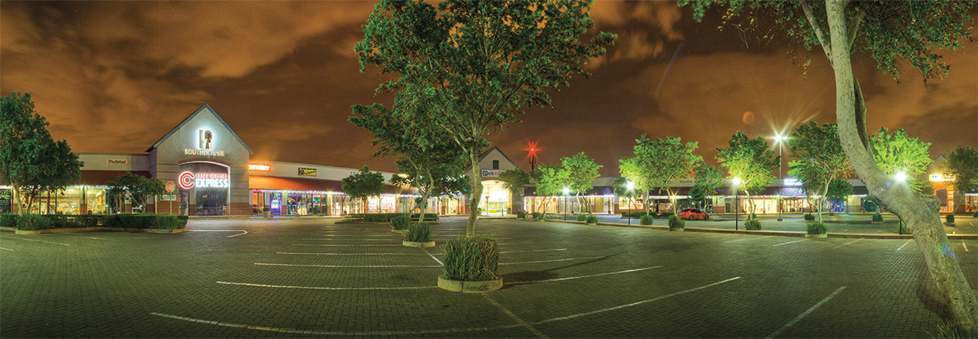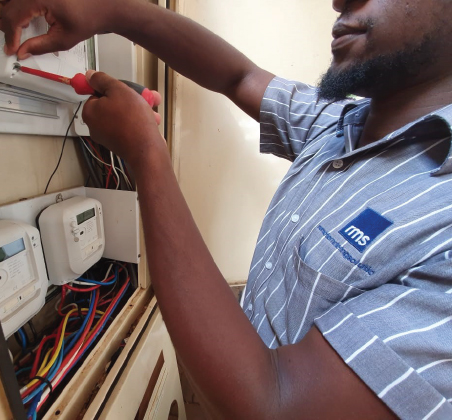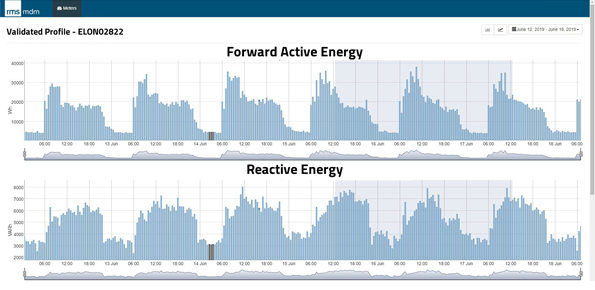
Project Overview
Rapfund provides locations for retail outlets in major municipalities in South Africa; currently there are 9 retail centres, between 3.5K and 18K square meters of retail space. The total retail space managed by Rapfund is 70,000 m2. Supply of energy to the retail tenants is an essential part of the service Rapfund provides to enable commerce – lighting, air-conditioning, power for IT including point of sale equipment. Energy and other utilities are provided by a municipality utility supplier to the landlord and then sub-metered to the tenant retail outlets by the landlord as one of the services they provide.
Making this sub-metering model benefit both the landlords and the tenants is an important part of the overall success of the business model that Rapfund promotes for its retail outlets.
RMS (Remote Metering Solutions) and NES (Networked Energy Services) have deployed sophisticated automated metering and supply control solutions, integrated with portal, billing and e-wallet solutions at the back-end, which allow the tenants and the landlord to gain mutual business advantage from this arrangement.
RMS used NES meters as the foundation for their sub-metering solution. RMS provides a turn-key and cloud-based environment for landlords to develop and maintain revenue flow for the utilities they sub-meter and for their tenants to manage their expenditure through the portal and e-wallet system. RMS also provides the O&M (Operations and Maintenance) services to keep the energy and utility infrastructure working optimally within the retail outlets.
Initially, around 500 smart meters were deployed, over a period of time, starting in 2016, across the retail space for Rapfund as an enabler for this innovative business model. Since then, the deployment has increased, and on-going expansion is continuing, aligned to Rapfund’s development and expansion of new retail outlets.
The Business Challenge
The supply of utilities can be a significant revenue stream for the landlord. The potential revenue is approximately $5.00 per square meter per month of commercial space, margin is typically around 10- 15%. Both can vary depending on tariffs applied by the municipality utility supplier and the tariffs and value-added services provided by the landlord to the tenants.
For landlords, a significant challenge, when leasing retail space, is cash-flow for utilities. The municipality utility supplier bills the landlord on post-pay and sometimes pre-pay contracts. The landlord must use a pre-pay model to recoup their expenses from their tenants as early as possible.
For the tenants, the challenge is to conveniently maintain control of their expenditures on utilities, leveraging the flexibility provided by the landlord to manage their own cash-flow.
National and regional policies of structured load-shedding require the landlord to augment the grid supply at specific times by generating energy locally, allowing tenants to continue their commerce during the grid black-outs. Although some of the energy shortfall is met by solar (PV) generation, it is largely addressed through diesel generators, which leads to a far higher cost per unit of energy. To maintain a healthy relationship between the landlord and the tenant, an equitable, transparent and fair dual-source billing solution is required for those times when the landlord is supplementing the grid energy supply.
Meeting these challenges with a win-win outcome required technology solutions which allow flexibility, agility and leveraging the sophistication of the metering infrastructure.
The Technology Challenge

The technical challenge was to deploy and maintain a sophisticated and reliable smart meter infrastructure and integrate it with cloud and ICT hosted back-end systems, to create comprehensive customer portals incorporating pre-pay, e-wallet and consumption analytics. Accurate, detailed and up-to-date metering information from the meters was key to ensure trust between the tenants and landlord. The software needed to be intuitive so that tenants can easily understand their consumption and demand.
The overall solution needed to ensure that the landlord can manage the reliable access to energy so that their tenants can continue with their commerce, even during grid outages.
The need to maintain continuity of supply brought additional technical challenges. The dual source billing solution ensured both the landlord and the tenant received a fair financial settlement when local supply was being used to augment grid supply.
Finally, the remote operation of the smart meters was a key element of making this solution cost effective and efficient. Reliable communications between the meter and the software ensured that up-to-date consumption information was available for pre-pay billing functions and to ensure that energy supply can be controlled in the event of non-payment, theft or fraud.
Business Objectives and Outcomes

For Rapfund, the key objective was to provide a repeatable technology solution that allowed landlords and tenants to work collaboratively towards the supply and consumption of utilities. This represented a differentiator for their business proposition. For the landlord, the key business outcome was to manage cash-flow for utilities consumed in their retail premises. This ensures that they can recoup outlay as quickly as possible through innovative tariffs that can incorporate elements of post-pay, prepay, flat rate, consumption-based and maximum consumption-based billing.
The RMS and NES solution deployed allows the landlord to implement pre-pay solutions for utilities, so they can avoid negative cash-flow.
NES smart meters automatically and reliably provide up-to-date and accurate information into the RMS cloud and hybrid IT platform, which includes rating, billing, pre-payment, e-wallet and consumption monitoring and projection tools. Thanks to the combination of software solutions and NES meters, the landlord can quickly disconnect supply automatically and so reduce their exposure to non-payment, theft or fraud.
A key factor in the NES AMI solution is its OSGP (Open Smart Grid Protocol) meters. The OSGP standard offers unrivalled communications reliability and security. Therefore, it can be deployed into Rapfund’s business model with complete confidence that metering data, configuration and firmware updates and supply connect/disconnect can be managed effectively and securely. Alignment to the OSGP standard means that Rapfund have the freedom to deploy other OSGP compliant meters seamlessly into the environment, should this be required.
Added advantages to the landlord include: nonrepudiation for the consumption charges, reduced number of disconnections (through better management of consumption by the tenants), opportunities to develop their own flexible tariffs, market differentiation when attracting tenants and ability to offer additional energy services such as PV infrastructure maintenance.
For the tenant, the key business outcome was to leverage flexibility in tariffs to better manage their charges for consumed utilities; primarily energy, but also water and sanitation. A portal allows them to predict their consumption of utilities based on analysis of historic information and identify inefficiencies in their use of energy consumption, as a result of the detailed metering information provided by NES and the sophisticated software solution provided by RMS. The software solution also includes an e-wallet, allowing the tenant to purchase energy, other utilities and other services in a convenient way.
The Result
The result is the application of technology to achieve a practical win-win for the landlords and the tenants. For Rapfund, this is as follows:
• 9 buildings
• Total GLA = 70,000 square meters
• Average annual utility revenue = US$3.4million
• Average monthly cost of utilities = US$4.07 per square meter
• 307 total sub-metered tenant count managed in Rapfund owned commercial premises
“Rapfund, RMS and NES have jointly applied technology to address some of the critical challenges of commerce in South Africa”, says Alan Menigo (COO). “The innovation of RMS and NES in developing an integrated solution is helping Rapfund create more opportunities for commerce as we expand our business.”
This model is repeated through multiple property asset investment organisations in South Africa and is essential in helping commerce to take place across the country. Through the application of technology, Rapfund has been able to create a business model which benefits both landlords and tenants alike.
The Future
The business model allows several innovations, which enrich the relationship for both the landlord and the tenant:
Local Energy Generation
Both the landlord and the tenant can generate energy locally through PV deployments and gain credit for the energy they supply into the grid. Many retail sites can generate 10%-15% of their energy consumption from PV deployments because of their large roof-space.
Repeatable Model for Other Markets
Although developed in South Africa, the model is applicable globally, with special interest in India and Middle-east. Thanks to the modular design of the NES smart meter infrastructure and the RMS cloud and hybrid-based systems, the solution can be rapidly deployed into new retail premises or as part of a retrofit.
Other Services
The e-wallet provided by RMS allows the landlord to monetise other services they provide beyond the energy and utilities managed by the current system.
Multi-utility Automated Pre-pay
The automated pre-pay features are provided for electricity usage currently, but the NES meters allow for capture of metering information from gas and water meters.
RMS and NES
This project was successful and continues to be so through the combination of technology by RMS and NES and by the collaborative nature of the two companies to meet Rapfund’s business objectives.
NES provided its industry leading AMI solution as a foundation layer for generating accurate and up-to-date consumption (and increasingly production) information and the controls for the supply in the event of non-payments or fraud.
“This innovative deployment of NES smart meters shows how technology can be applied to achieve a win-win relationship between landlords and tenants, with the end-goal being continued commerce”, says Mark Ossel, VP Global Alliances at NES. “We are proud to have worked with RMS to achieve a project that benefits the local companies in South Africa.”
RMS provided the software to expose this information in an intuitive way for landlords and tenants, as well as the services to ensure that this sophisticated solution remains at the peak of operation.
“RMS regards NES smart metering technology and the OSGP standard as one of the foundation stones of its sub-metering solution” says Hendrik Greyling, RMS CEO and Board Member of the OSGP Alliance. “Reliable, accurate, detailed and frequent metering and control enables RMS to develop sophisticated cloud-based solutions for Rapfund, and similar customers in South Africa”.
RMS is a Master-VAR for the supply of NES smart meters in South Africa.

